How Much Does it Cost to Create On Demand Marketplace

In a world where everything is moving too fast, driven by the desire to acquire what we want or need now and without much effort on our part convenience coupled with accessibility makes on-demand always available markets become perhaps essential in today’s contemporary society. With the rise of on-demand services, traditional business models have undergone significant changes whereby users are able to get quick solutions to their needs. And People can now hail any ride, look for a local service provider and even have the groceries delivered to their doorsteps all owing to on-demand marketplaces which are an inherent part of our lives.
How much would it cost to develop an on-demand Marketplace like eBay, Etsy and Amazon? Many other attempts have been made to calculate the costs of building similar platforms online, but only those who own such a platform know exactly what it took for them.
However, this post detailed actual B2C marketplace projects that the Addevice's team has worked on. So, in your own estimates you will be able to use real numbers as a source of reference. In addition, after reading this guide you will be able to create your estimation of the project cost without any help.
Now, let’s look at rough estimates for marketplace website development costs based on project scope:
- Small marketplace project (a basic online platform for buying and selling a single type of product or service): $88,000 - $136,000;
- Medium-complexity project (a platform for buying and selling a variety of products from different sellers): $108,000 - $167,000;
- Complex marketplace (having advanced features and potentially cutting-edge technologies): $143,000 - $218,000
These approximations apply to these figures since there is no formal classification of marketplace projects. Use them as benchmarks to see the level of function you can anticipate within your recommended budget.
Join us as we discover the intricacies and details of developing an on-demand marketplace to learn how much money it takes to bring a dream into reality.
What is an On Demand Marketplace?
An on-demand platform is a digital site that links people with immediate access to products, services or qualified experts. This information society is characterized by dynamic online needs whereby consumers can instantly satisfy their wants when they are able to order products or services on demand leveraging mobile apps, websites etc.
These marketplaces use technology to connect service providers and consumers in real time. On-demand marketplaces aim to fulfill increasing demand for instantaneous solutions-by arranging rides, hiring local experts in the required field of service or ordering groceries delivered within a short time.
Just by a few taps, users enjoy diverse offerings from various business models bringing efficiency to businesses. This progressive method does not only respond to the emerging needs of current consumers but also provides businesses with new opportunities for prosperity in digital space.
In essence, an on-demand marketplace fuses technology and services together that turn out to bring instant solutions for particular needs with immediate requirement which is the very demand of today’s hectic life.
Factors That Affect the Cost of On-Demand Marketplace Development
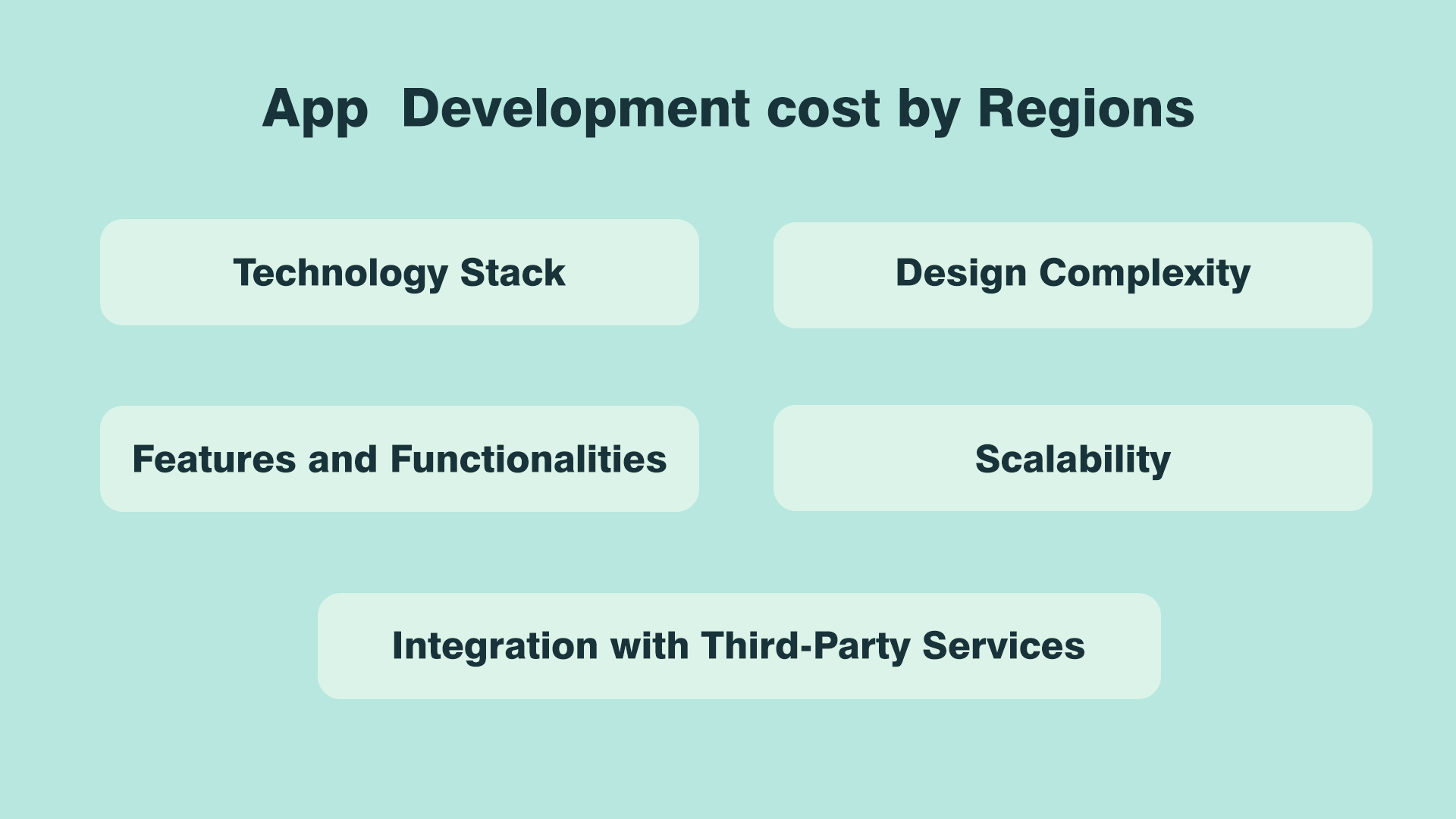
The development cost of an on-demand marketplace greatly depends on multiple factors that directly affect the end product. Starting from the core technology to complicated design and scalability details every factor has its important contribution in ensuring how much money should be spent on bringing such a platform into reality.
Technology Stack
The selection of the best technology stack is one of the most important factors steering towards development method, speed, and scalability that are used by developing on-demand marketplace. Here's an example of a technology stack for a web and mobile-based marketplace:
| Aspect | Web Development | Mobile Development |
|---|---|---|
| Frontend Framework | React, Angular, or Vue.js | React Native, Flutter, Xamarin |
| Backend Framework | Django, Ruby on Rails, Express.js | Django, Node.js, Flask |
| Database | PostgreSQL, MongoDB, MySQL | SQLite, Realm, Firebase Realtime Database |
| Hosting | AWS, Heroku, DigitalOcean | AWS, Firebase, Microsoft Azure |
The selection of a suitable technology is conditioned by several factors, including the scale and technical complexity at which one works; project speed ratices development chains formation time allowed for training programmer skills on specified technologies to ensure long-term maintainability.
Features and Functionalities
The price is directly dependent on the complexity and number of features. The following are the features for both web and mobile versions։
| Feature | Web Version | Mobile Version |
|---|---|---|
| User Registration and Profiles | Standard sign-up, profile creation | Social media logins, customizable user profiles |
| Service Listing and Search | Basic listing with search functionality | Advanced filters, geolocation-based search |
| Real-time Tracking | Basic status updates | GPS tracking, live location sharing |
| Payment Processing | Standard payment gateways (e.g., Stripe) | In-app wallets, multiple payment options |
| Reviews and Ratings | Basic rating system | Detailed reviews, multimedia content support |
Developing the latest features improves user experience while at the same time increasing development cost.
Design Complexity
The level of the user engagement with an object depends on its design. Here's an example of design considerations for both web and mobile versions:
| Design Aspect | Web Version | Mobile Version |
|---|---|---|
| UI/UX Design | Clean and intuitive design | Mobile-friendly, gesture-based controls |
| Responsiveness | Responsive layout for various screens | Tailored design for different devices |
| Branding and Theming | Standard branding elements | Customized themes and brand integration |
It is beneficial for users because of the investment in a well-designed website that has an intuitive layout without compromising aesthetics, but it affects development costs.
Scalability
The on-demand marketplace needs to be scalable so as to accommodate an increasing number of users. Example considerations include:
| Scalability Aspect | Example Considerations |
|---|---|
| Efficient Database Design | - Utilize indexing and proper normalization to optimize query speed. |
| - Implement sharding or partitioning strategies for data distribution. | |
| - Regularly perform database maintenance for optimal performance. | |
| Implementation of Caching Mechanisms | - Employ caching for frequently accessed data to reduce load times. |
| - Use content delivery networks (CDNs) for static content caching. | |
| - Implement edge caching for geographically distributed users. | |
| Cloud-Based Infrastructure | - Leverage cloud platforms like AWS, Azure, or Google Cloud. |
| - Utilize auto-scaling features to adapt resources based on demand. | |
| - Implement load balancing for even distribution of user requests. | |
| Ensuring Scalability from the Outset | - Design the architecture with horizontal scaling in mind. |
| - Regularly monitor system performance to anticipate growth. | |
| - Conduct stress testing to identify potential scalability issues. |
The scalability of a solution to be developed is that the market platform on demand can accept more requests from users at higher traffic but without affecting performance under load. These include optimization of the database, cloud computing infrastructure that allows foundation for a future-proof scalable platform.
Integration with Third-Party Services
The integration of the on-demand marketplace with this and other numerous external services aimed at its betterment is another important feature. Here are examples of integrations for both web and mobile versions:
| Integration Service | Web Version | Mobile Version |
|---|---|---|
| Geolocation Services | Google Maps API | Mapbox, Google Maps SDK |
| Payment Gateway | Stripe, PayPal | Braintree, Apple Pay, Google Pay |
| Push Notification Service | Firebase Cloud Messaging (FCM) | OneSignal, Pusher |
| Analytics and Monitoring | Google Analytics | Firebase Analytics, Mixpanel |
This simplifies the functionality of the marketplace by allowing it to integrate with third-party systems; however, such integration requires additional cost and dependency.
On-demand marketplace development cost results in consideration of the complexity of technology stack, richness features, design sophistication and related scalability issues as well third party integrations. To succeed in these endeavors, finding the best balance determined by business needs and user expectations is paramount.
Cost Breakdown for Marketplace Development
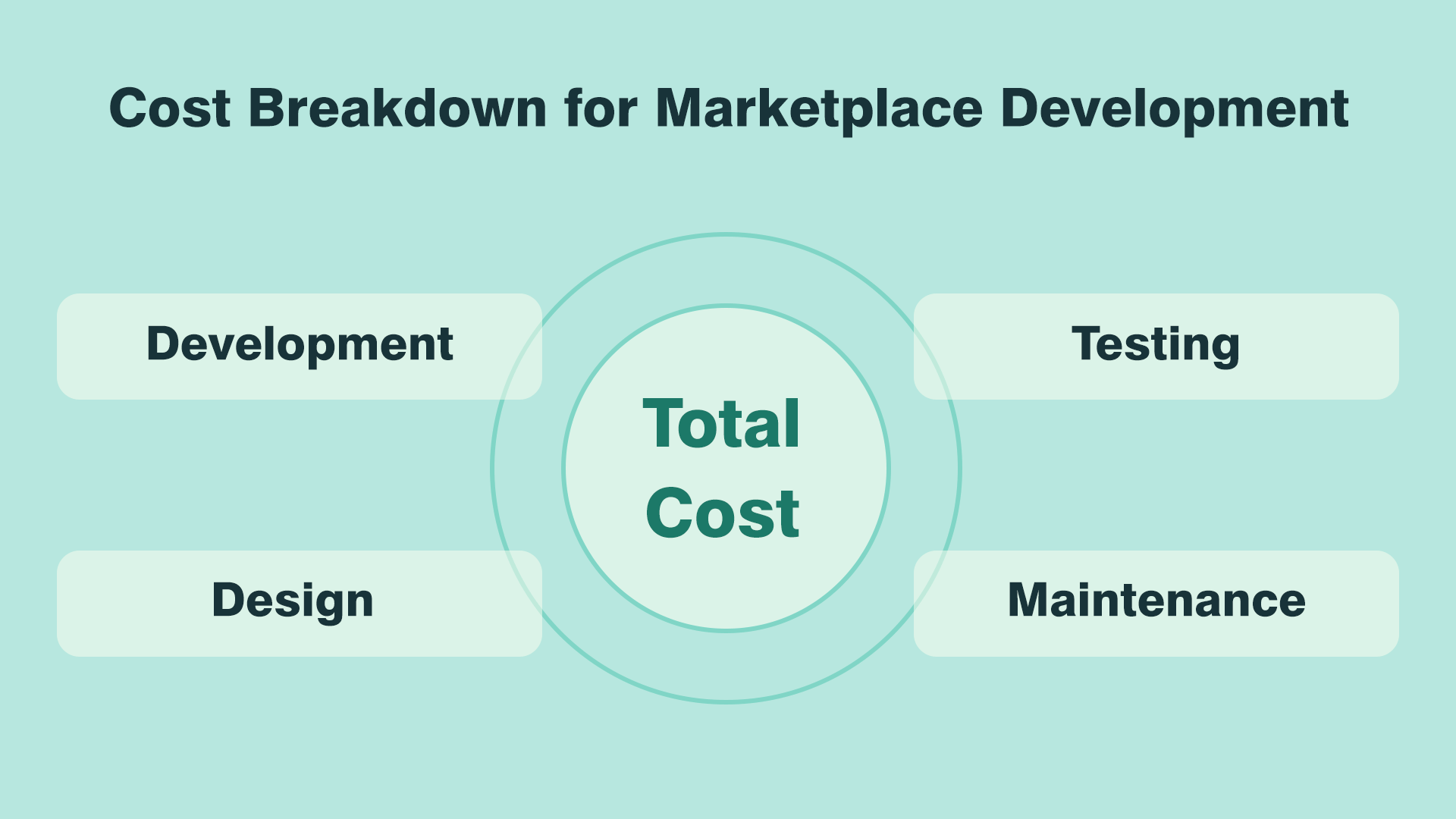
There are many costs of establishing a market while others argue that it is possible to cut the cost as low as can be in some cases if we look closely at what exactly these various stages do include, then development stage among other composition elements such design and testing should continue with an ongoing maintenance. Here's a detailed breakdown of these costs:
Development Costs
| Development Aspect | Web Version ($) | Mobile Version ($) |
|---|---|---|
| Frontend Development | $12,000 - $20,000 | $15,000 - $25,000 |
| Backend Development | $18,000 - $25,000 | $20,000 - $30,000 |
| Database Setup and Management | $6,000 - $8,000 | $8,000 - $10,000 |
| Third-Party Integrations | $5,000 - $10,000 | $6,000 - $12,000 |
| Total Development Costs | $41,000 - $63,000 | $49,000 - $77,000 |
Design Costs
| Design Aspect | Web Version ($) | Mobile Version ($) |
|---|---|---|
| UI/UX Design | $10,000 - $15,000 | $12,000 - $18,000 |
| Responsive Design | $5,000 - $8,000 | $6,000 - $10,000 |
| Branding and Theming | $3,000 - $5,000 | $4,000 - $6,000 |
| Total Design Costs | $18,000 - $28,000 | $22,000 - $34,000 |
Testing Costs
| Testing Aspect | Web Version ($) | Mobile Version ($) |
|---|---|---|
| Quality Assurance Testing | $8,000 - $12,000 | $10,000 - $15,000 |
| User Acceptance Testing (UAT) | $4,000 - $6,000 | $5,000 - $8,000 |
| Bug Fixing and Iterations | $5,000 - $8,000 | $6,000 - $10,000 |
| Total Testing Costs | $17,000 - $26,000 | $21,000 - $33,000 |
Maintenance Costs
| Maintenance Aspect | Annual Cost ($) |
|---|---|
| Hosting and Server Maintenance | $3,000 - $5,000 |
| Regular Updates and Bug Fixes | $5,000 - $8,000 |
| Security and Performance Monitoring | $4,000 - $6,000 |
Total Costs for Marketplace Development
| Development Complexity | Small Project Total Cost ($) | Medium-Complexity Project Total Cost ($) | Complex Project Total Cost ($) |
| Development Costs | $41,000 - $63,000 | $50,000 - $77,000 | $65,000 - $100,000 |
| Design Costs | $18,000 - $28,000 | $22,000 - $34,000 | $30,000 - $45,000 |
| Testing Costs | $17,000 - $26,000 | $21,000 - $33,000 | $28,000 - $43,000 |
| Maintenance Costs | $12,000 - $19,000 | $15,000 - $23,000 | $20,000 - $30,000 |
| Total Project Cost Range | $88,000 - $136,000 | $108,000 - $167,000 | $143,000 - $218,000 |
*The cost ranges presented above are estimates and may differ depending on project specifications, location, developer rates among others.
Varpet: A Case Study in On-Demand Marketplace Development
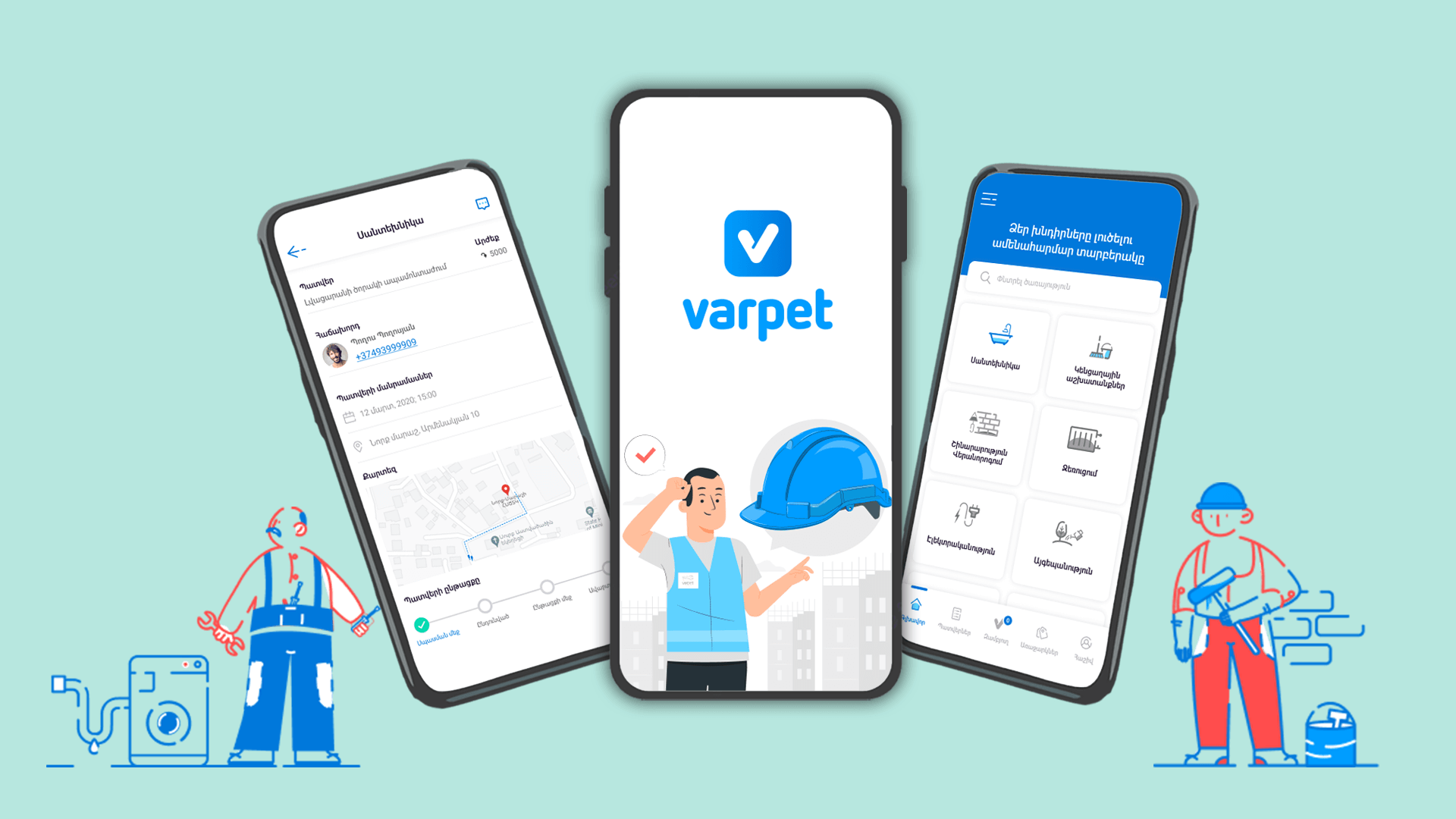
In the world of on-demand marketplaces, Varpet is a brilliant case study demonstrating Addevice’s ability to deliver creative and functional solutions. Varpet which is a two-sided marketplace, developed by Addevice platform connects users with local craftsmanship or masters in real time. This case study provides insight into the distinctive characteristics of Varpet and its ability to solve common issues with help from a dynamic marketplace model.
Introducing Varpet
Varpet which translates to "master" (Վարպետ) in Armenian, serves this title by being a complete problem solver for everyday challenges. Built by Addevice, a leading company in the domain of app and web development, Varpet has transformed how users seeking to avail specialized services meet professional experts near them.
Unique Features of Varpet
- Real-Time Matching: The specialty of Varpet is that it allows users to connect with local masters in real time. This not only facilitates quick response times but also improves the user’s experience by offering immediate solutions to their needs.
- Diverse Service Offerings: Varpet deviates from the routine and offers as many services. First, they are able to find masters from house repairs using specialized skills and then with the services of different tasks that provide them on-need stop shop service needs.
- User-Friendly Interface: This ease of use capability as exhibited in Addevice can be seen with Varpet. The structure of the platform provides simple navigation so that users can reach required services in no time and connect directly with masters.
Addressing Common Problems
Varpet's two-sided marketplace model addresses common problems faced by both service seekers and providers:
- Accessibility: It eliminates the accessibility issue with immediate help when users need it through its real-time connection platform. The user interface is also catered for an ordinary man in such a way that they can easily locate their local gurus.
- Job Opportunities for Masters: Varpet is beneficial not only for the customers but also provides a channel through which consumers can show their skills and find work. This eliminates the issue that most local service providers have when communicating with potential customers.
- Efficiency and Convenience: A solution that is efficient and easy to use Varpet’s real-time match and the array of services Users accomplish numerous activities without requiring prolonged research or working with several suppliers.
With Varpet as an example, Addevice demonstrates its capacity to create on-demand marketplaces. Given its specific features, as well as the user-centric approach adopted by this platform that makes it easy to use for people encountering common problems and allowing service providers deliver efficient solutions. Varpet serves as a reminder that on-demand marketplaces have the potential to revolutionize daily tasks by uniting communities.
Real-time Matching and Local Labor on Varpet
In the world of on-demand marketplaces, Varpet’s unique real time matching with local labor known as masters stands out. With this ground-breaking approach, the notion of how users interact with local skilled professionals is completely transformed into a straightforward and prompt solution to many issues.
Real-time Matching
Varpet achieves success based on its real-time matching capability. This feature enables the user to communicate with local gurus immediately. Every time a user publishes a service request, Varpet’s intelligent algorithms quickly process the purpose of publishing and find masters in the vicinity with required skills where they are located. This dynamic matching ensures speedy response times and maximizes service delivery efficiencies.
Benefits for Users Seeking Immediate Solutions
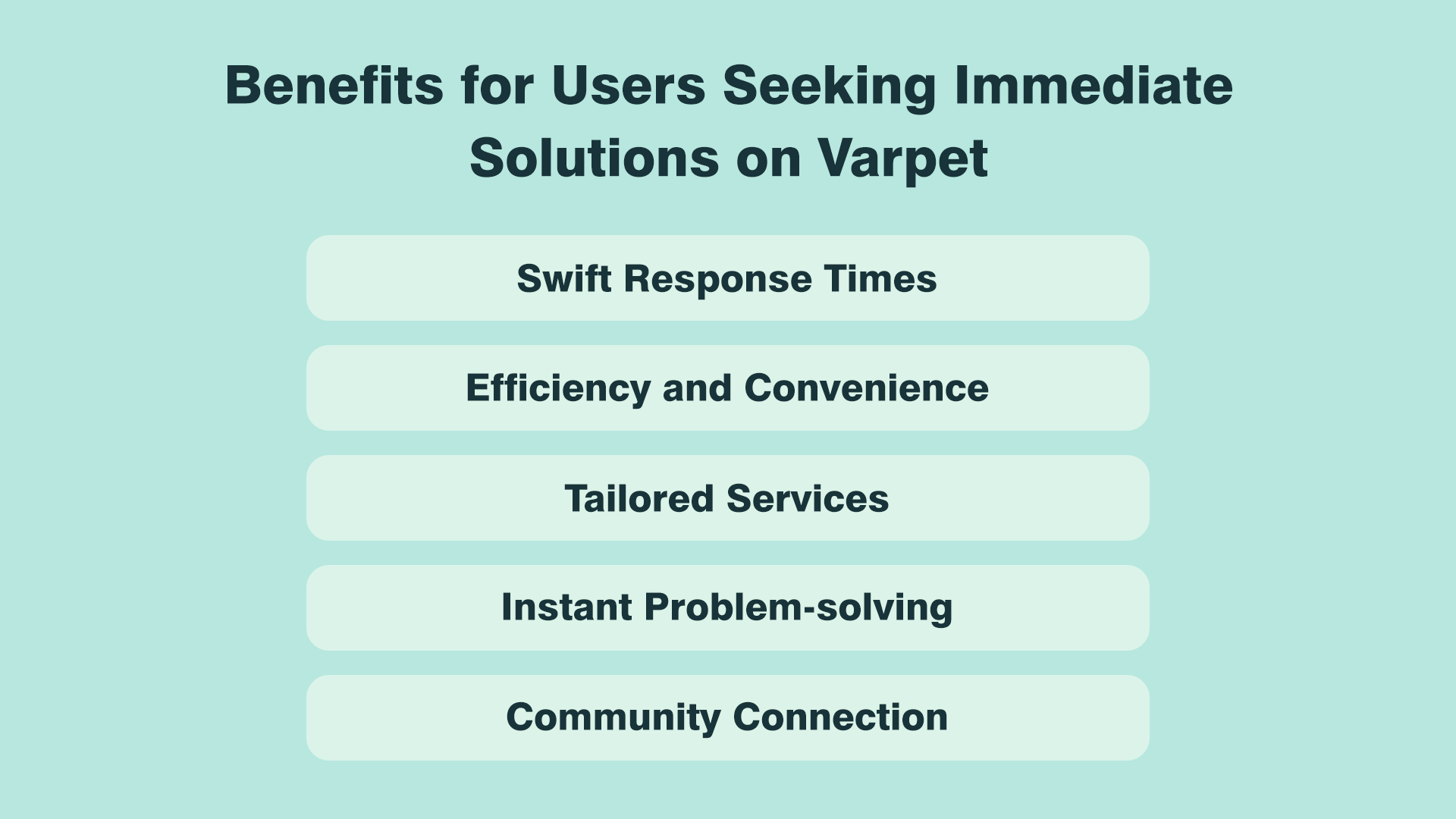
- Swift Response Times: Varpet live matching eliminates the usual delays of searching for traditional services. For users that require immediate help, it is simple to find a local master who is willing and available for assistance pertaining to their individual problem.
- Efficiency and Convenience: The real-time matching capability simplifies the entire process, allowing users to efficiently manage it. Users do not need to waste precious time conducting research and trying to reach different service providers; with Varpet, they can pinpoint fast solutions at any given moment improving overall productivity.
- Tailored Services: Through the real time communication of users with local masters, Varpet guarantees that it provides tailor made services. By providing a personal touch, this method improves the quality of user experience and increases chances for successful resolution.
- Instant Problem-solving: In fact, any household repairs or technical problems on a user’s part while they may need to contact Varpet real-time matching service allows them to put their matters into action instantly. This fast response capability answers to the needs of a dynamic contemporary life, offering relevant service immediately.
- Community Connection: Varpet’s model promotes community membership. Users not only enjoy fast service delivery but also contribute to the community of skilled professionals by giving them employment opportunities. This union approach increases cohesion in the community and boosts local economies.
Varpet’s real-time linkage of local labor and traditional service seeking are transformed in the middle stream due to technology. Thanks to the utilization of technology that smoothly links users with nearby professionals in time, Varpet meets not only some urgent needs but also fills an efficient and user-friendly connection into its system which is a defining characteristic of successful on-demand marketplaces.
Impact of Varpet's Model on Development Costs
Varpet's unique model, mainly its instant matching with local labor introduces new features which can affect the development expense within comparison to traditional on-demand marketplaces. Let us see how Varpet’s method may affect the development costs and speak about savings potential and productivity increase.
Comparison Table: Varpet vs. Traditional On-Demand Marketplace
| Aspect | Varpet's Model | Traditional Model |
|---|---|---|
| Real-time Matching | Efficient algorithm-driven matching | Predefined algorithms or manual matching |
| Geolocation Features | In-depth integration for real-time user tracking | Basic location-based services |
| Service Diversity | Diverse service offerings | Limited service categories |
| User Interface/Experience | Intuitive design tailored for real-time interactions | Standard design with generic features |
| Customization for Masters | Tailored profiles for masters with real-time availability | Standard profiles and scheduling features |
| Community Collaboration | Facilitates community connection and local economic support | Traditional marketplace may lack community emphasis |
Potential Cost Savings with Varpet's Model
Efficient Algorithm-driven Matching
- Cost Saving: The intelligent matching algorithm that was done by Varpet has greatly decreased the need for intense manual efforts while working with user pairing and local masters.
- Example: Such a medium sized project can save roughly $5,000 by eliminating days in manual development up to 20%.
Geolocation Features for Real-time User Tracking
- Cost Saving: The deep integration into geolocation services guarantees correct tracking, effectively disposing of the need to create other functionalities associated with tracing.
- Example: Since the time necessary for developing location-based features is reduced by 15%, which means that in terms of money it represents approximately $4,000.
Tailored Profiles and Scheduling for Masters
- Cost Saving: The scheduling features can be simplified using profile customization for masters whose availability is real-time, which saves development hours.
- Example: It can minimize $3,000 and the profile customization takes 10% less of the development time.
Community Collaboration and Economic Support
- Cost Saving: As community collaboration helps in reducing the marketing costs, it also leads to an increase of user engagement and retention over time.
- Example: In the long-run, such engagement driven by the community saves $2,000 worth a 10% reduction in customer acquisition costs.
Total Potential Cost Savings
With the help of Varpet’s model, using these efficiency-enhancing elements would lead to total cost savings around $14,000 - $15,000 in a medium scale work.
Such numbers can result in real cost optimization and improved operational effectiveness relative to standard on-demand marketplace design.
Conclusion
Our study of Varpet and its unparalleled features has shed light on the variables shaping costs in this dynamic field of on-demand marketplace development.
The question that informed our investigation was, "How much does it cost to create an on-demand marketplace?" Answering this involves broken down by technology features and design complexity.
As you plan your on-demand marketplace project, be guided by its main objectives and highest priorities. That's why Varpet’s progressive model offers some insight into how well-thought features and community coordination can change user experience as much as the cost of development. Customize your methodology according to the specific needs of a prospective client and relative field.
An understanding of technology, user demands and the community balance is crucial to successful marketplace development in a fast-changing climate for on-demand services. Through careful consideration of these aspects, entrepreneurs can not only develop efficient and user-friendly platforms but also promote development cost optimization for continued growth.
It’s time to take advantage of what can be offered by Varpet model or develop your own on-demand marketplace. Contact us today! So our Addevice team is ready to breathe life into your vision, using its skills in development and fresh ideas plus easy user navigation. Let’s turn your ideas into a successful digital marketplace.
Unlock the Potential of On-Demand Marketplaces
Discover the cost-effective journey of creating your On-Demand Marketplace with Addevice, a top-rated app development company.
Our offerings include:
✅ Dedicated development team
✅ Extended development team
✅ Comprehensive product development from scratch
Table of contents
FAQ
Cost is dependent on aspects such as functionality, tech stack used and design intricacy. A limited project may cost between $88,000 and $136,000 while an elaborate one can be as much as up to $143,000 - $218,000.
The unique advantage of Varpet is a live connection to the local masters who address issues instantly. The collaboration between the community and its diverse services creates a novel experience that accommodates efficiency as well as local support for economic growth.
The efficiency-enhancing dimension of Varpet’s model includes aspects such as real-time matching and personalized profiles, which could result in cost savings. For instance, algorithm-driven matching can save development hours thus leading to real savings.
Absolutely! Varpet's suitability to such industries and service types, based on the level of flexibility that it possesses. And if you are in home services, freelance or in special skills the model can be adjusted to fit your situation.
Addevice focuses on the development of online marketplaces that are based on demand. We customize solutions to meet your vision while providing the expertise in technology, efficiency of features and user-friendliness. Feel free to reach out so that your ideas can turn into a fully functioning digital space.
 Grocery Delivery App Development: Tips, Cost & Steps
Grocery Delivery App Development: Tips, Cost & Steps
 How To Make Online Selling App? Tech & Business Details
How To Make Online Selling App? Tech & Business Details
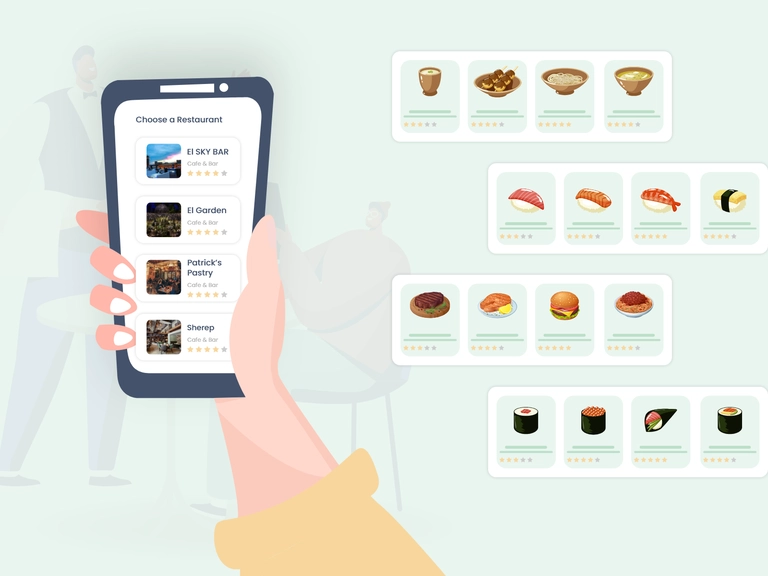 Create Restaurant App: Features, Cost & Tech Details
Create Restaurant App: Features, Cost & Tech Details